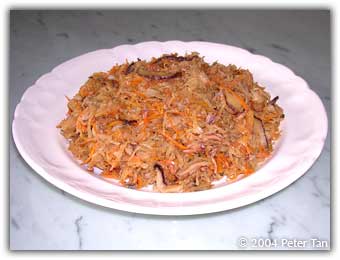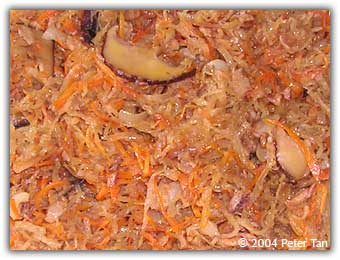
Today I had jiu hoo char and the leftover sambal petai prawns for lunch. It was one of the best jiu hoo char I have had in a long time. And it came from my kitchen! I have this to confess. All the times when I said that I cooked this and baked that, I was only instructing the maid. She did most of the peeling, cutting and frying. I would occasionally show her how to cut the ingredients and help with the stir-frying. She had looked after Mum for one week before Mum passed away. Seeing her dedication in caring for Mum, Peter and I decided to employ her. She is not adept at cooking but is a fast learner.
Cooking jiu hoo char involves tedious cutting of the ingredients and then another one half hour patiently stir-frying it. This is a Hokkien dish which means fried cuttlefish. It is usually cooked only during major festivals such as the Chinese New Year and for praying to the deceased on the Chinese seventh month and death anniversaries. It also used to be one of the main dishes for wedding eve dinners and wedding day lunch which is now mostly being replaced with buffet for aesthetic purposes and convenience.
I am glad that I had picked up bits and pieces of cooking tips from Mum. She had always shared with me the ingredients that she used and how best to cook a particular dish. I have never really cooked a full meal before except soups for Mum every day when she was ill. That also was easy because all I had to do was wash the ingredients, put it all into the slow cooker, add hot water, turn the cooker on, and it would be ready a few hours later. Mum had a wide repertoire of dishes but I cannot remember them all. I can only recall some of those that she cooked often or some that left an indelible impression because they tasted real good. Jiu hoo char is one of them.
First and foremost, a good jiu hoo char must have its sengkuang, carrots, mushrooms and pork sliced into thin layers and then finely shredded, preferably cut by hand with a knife. Those that are processed with a metal shredder would be mushy and not taste as good. It is also important to stir fry the garlic, cuttlefish and onions until fragrant before adding the other ingredients.

Jiu Hoo Char
Ingredients:
600g sengkuang
2 medium sized carrots
3 onions
4 cloves garlic, chopped
6 shiitake mushrooms
50g shredded dried cuttlefish
200g belly pork, skin removed
3 tablespoons cooking oil
1 teaspoon salt
Soak mushrooms in 1 cup of hot water for about 30 minutes. Keep the water that mushrooms had been soaking in. Rinse shredded cuttlefish and leave to dry. Cook meat in boiling water and remove. Finely shred sengkuang, carrots, mushrooms and pork. Cut onions into halves and then slice thinly.
Heat oil in wok. Add garlic and stir-fry until fragrant. Add cuttlefish and stir-fry until fragrant. Add onions and pork and stir-fry until fragrant and onions are soft. Add the rest of the shredded ingredients and stir-fry until they become soft and turn a few shades darker. Add salt. Add mushroom water bit by bit, stirring all the time to prevent the vegetables from burning and sticking to the bottom of the wok. Continue stirring until fragrant, the volume of the ingredients reduced by half, which should be approximately one half hour.
This is not the definitive jiu hoo char recipe. The ingredients and cooking methods were as much as I could recall. I am sure there are some ingredients and steps that I had missed. I think Mum also used scallions and coriander. I did not have those as I only decided to cook this dish when I saw that I had most of the main ingredients. Still, I am satisfied with the outcome. It tasted just sweet enough without sugar being added. Usually sugar is not needed as the sengkuang would sweeten the dish when sufficiently cooked.
I like my jiu hoo char with rice. Some prefer to wrap it in Chinese lettuce or popiah skin. Jiu hoo char keeps well. In fact, it tastes even better if kept overnight and then heated again. It is usually cooked enough for a few meals. Mum used to cook more than we could eat. The leftovers were used to cook chai boay. Chai boay means leftovers in Hokkien. This is usually a hodgepodge of leftovers from a major feast cooked in a big pot together with roasted pork trotters, salted vegetables, onions, sengkuang, mushrooms and dried chillies among others. Adding jiu hoo char to chai boay greatly enhances its taste and flavour.
